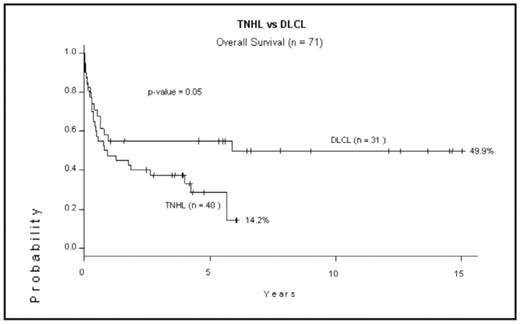Abstract
No data are available in the literature comparing the outcome of myeloablative allogeneic SCT (allo-SCT) for patients with refractory/relapsed de novo diffuse large B-cell lymphoma (DLBCL) and transformed lymphoma (TNHL). We hypothesized that outcomes would be similar for these 2 groups. In this single centre, population based study, a total of 71 such patients underwent allo-SCT (Oct 87 to Feb 07), 40 (56%) with TNHL and 31 (44%) with DLBCL. The 2- and 5-y OS for the whole group is 46% and 41% respectively, with median follow up for surviving pts of 67 months (range 13 – 183 m). The 1-y cumulative incidence (CI) of relapse and TRM for the whole group is 27% and 27% respectively. There were no significant differences between baseline characteristics for the two groups including: median age at diagnosis, stage, B-symptoms, IPI at diagnosis, number of prior therapies, CMV status of donor and recipient, donor type, level of HLA matching and conditioning regimen. Median age at SCT was 58 for TNHL compared to 50 for DLBCL (p<0.001) and more patients received prior rituximab therapy in the TNHL group (35%) compared to the DBCL group (13%), (p=0.03). Sixteen of 31 patients (53%) with DLBCL and 11 of 40 (27.5%) with TNHL are alive. Overall (OS) and event-free survival (EFS) are superior for the DLBCL group compared to the TNHL group mainly due to lower risk of therapy related mortality (TRM). OS for the DLBCL and TNHL groups at 2-y and 5-y are 55% vs 40% and 55% vs 28% respectively, (p=0.05). EFS for the DLBCL and TNHL groups at 2-y and 5-y are 52% vs 35% and 48% vs 27% respectively, (p=0.1). The CI of disease relapse post allogeneic stem cell transplantation for the DLBCL and TNHL groups are similar at 1-y: 32% vs 23% and at 5-y: 36% vs 36% respectively, (p=0.9). TRM is significantly lower for the DLBCL compared to the TNHL group with 1- and 5-year CI - TRM at 16% vs 35% and 16% vs 38% respectively, (p=0.04). Early complications post-allogeneic stem cell transplantation (Bearman toxicity criteria) were similar in both groups. The CI of grades II–IV acute graft host disease (aGvHD) is41% for DLBCL and 60% for TNHL (p=0.08). The cumulative incidence of aGvHD grades III/IV was lower in the DLBCL group (7%) compared to the TNHL group (25%), (p=0.049). The cumulative incidence of chronic GvHD (cGvHD) at 3 years was non-significantly higher in the DLBCL (48%) compared with the TNHL group (27%) (p=0.14). In summary, patients with refractory/relapsed de novo DLBCL treated with allogeneic SCT have better outcome compared to those with TNHL. There is a plateau on the survival curve at 50% for DLBC NHL, with good long-term disease-free survival. The same is not true with allo HSCT for T NHL, whereby a continuous pattern of failure is seen.
Table: Basic characteristics of follicular and transformed groups.
| Parameter . | TNHL (%) . | DLBCL (%) . | P-Value . |
|---|---|---|---|
| *at diagnosis | |||
| Patient number | 40 (56) | 31 (44) | 0.342 (Ho: porp=0.5) |
| Gender: Male/Female; Ratio | 27/13 (67.5/32.5); 2/1 | 16/15 (52/48); 1:1 | Chi-squared test: 0.174 |
| Age (years): Median / Range | 44 / 28 – 58 | 38 / 15 – 50 | t test (equal means): <0.001 |
| Donor Type: Sibling/ unrelated | 25 / 15 (62.5 / 37.5) | 25 / 6 (81 / 19) | Chi-squared test: 0.10 |
| Stage: * | Fisher test: 0.296 | ||
| I/II/III/VI | 2/2/6/30 (5/5/15/75) | 1/5/7/18 (3/16/23/58) | |
| IPI (number of factors)(0–1 vs 2–5) * | Chi-squared test:0.4 | ||
| 0/1 | 5/13 (12.5/32.5) | 3/8 (10/26) | |
| 2/3 | 15/5 (37.5/12.5) | 7/9 (23/29) | |
| 4/5 | 2/0 (5/0) | 4/0 (13/0) | |
| Parameter . | TNHL (%) . | DLBCL (%) . | P-Value . |
|---|---|---|---|
| *at diagnosis | |||
| Patient number | 40 (56) | 31 (44) | 0.342 (Ho: porp=0.5) |
| Gender: Male/Female; Ratio | 27/13 (67.5/32.5); 2/1 | 16/15 (52/48); 1:1 | Chi-squared test: 0.174 |
| Age (years): Median / Range | 44 / 28 – 58 | 38 / 15 – 50 | t test (equal means): <0.001 |
| Donor Type: Sibling/ unrelated | 25 / 15 (62.5 / 37.5) | 25 / 6 (81 / 19) | Chi-squared test: 0.10 |
| Stage: * | Fisher test: 0.296 | ||
| I/II/III/VI | 2/2/6/30 (5/5/15/75) | 1/5/7/18 (3/16/23/58) | |
| IPI (number of factors)(0–1 vs 2–5) * | Chi-squared test:0.4 | ||
| 0/1 | 5/13 (12.5/32.5) | 3/8 (10/26) | |
| 2/3 | 15/5 (37.5/12.5) | 7/9 (23/29) | |
| 4/5 | 2/0 (5/0) | 4/0 (13/0) | |
Figure
Disclosures: No relevant conflicts of interest to declare.
Author notes
Corresponding author


This feature is available to Subscribers Only
Sign In or Create an Account Close Modal